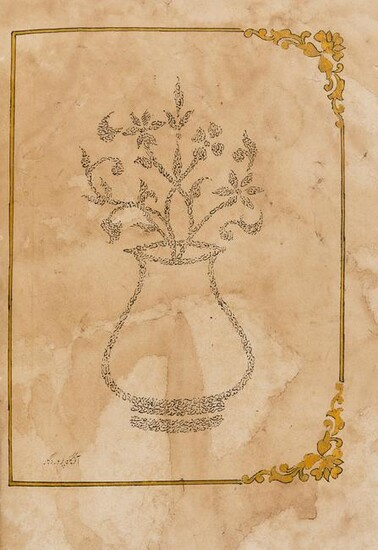Asian calligraphic manuscript.- Compilation of 43
Asian calligraphic manuscript.- Compilation of 43 calligraphic drawings in miniature Ghubari script, title with a prayer to the Prophet Muhammad within ruled border of yellow and yellow and black decoration in the Chinoiserie style at head (probably from a different work), 43 calligraphic drawings on 22 leaves, each within gold decorative Chinoiserie border (some incomplete), the first and last depicting a vase of flowers, others with one of the names of God, browned and stained, later limp cloth, stitched, 4to (295 x 211mm.), Probably China or S.E. Asia, 19th century.
Saleroom notice: the text is printed not manuscript
⁂ According to Sheila Blair, "Ghubar is derived from naskhi script, and its minuscule letters are usually less than 3 mm., often as small as 1.3 mm. Ghubar script is said to have been invented to write messages carried by pigeon post, but calligraphers in Iran came soon to use it in other ways, notably for amulets, talismans, and even entire copies of the Qur'an" see Islamic Calligraphy, Edinburgh, 2006, pp.259-260.
Sale price
Estimate
Time, Location
Auction House
Asian calligraphic manuscript.- Compilation of 43 calligraphic drawings in miniature Ghubari script, title with a prayer to the Prophet Muhammad within ruled border of yellow and yellow and black decoration in the Chinoiserie style at head (probably from a different work), 43 calligraphic drawings on 22 leaves, each within gold decorative Chinoiserie border (some incomplete), the first and last depicting a vase of flowers, others with one of the names of God, browned and stained, later limp cloth, stitched, 4to (295 x 211mm.), Probably China or S.E. Asia, 19th century.
Saleroom notice: the text is printed not manuscript
⁂ According to Sheila Blair, "Ghubar is derived from naskhi script, and its minuscule letters are usually less than 3 mm., often as small as 1.3 mm. Ghubar script is said to have been invented to write messages carried by pigeon post, but calligraphers in Iran came soon to use it in other ways, notably for amulets, talismans, and even entire copies of the Qur'an" see Islamic Calligraphy, Edinburgh, 2006, pp.259-260.



